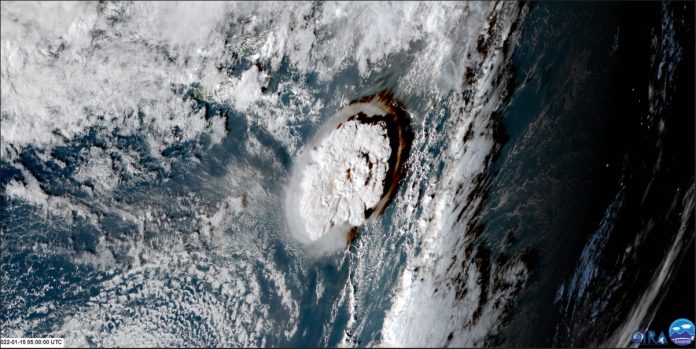Joseph Huba, Vice President at Syntek Technologies looks at the Tonga Volcanic Eruption and results from a high-resolution simulation of the event to model the Ionosphere response
The Tonga Volcanic Eruption, known technically as the Hunga Tonga-Hunga Ha’apai eruption, occurred on 15 January 2022 at 04:14 UT and was estimated to have released – 9 – 37 megatons of TNT equivalent [Astafyeva et al., 2022]. The eruption generated a massive atmospheric disturbance that caused major effects on the ionosphere worldwide.
Zhang et al. (2022), using total electron content (TEC) data from the Global Navigation Satellite System (GNSS), reported that traveling ionospheric disturbances (TIDs) circled the earth three times and lasted 4 days. Aa et al. (2022) reported a train of equatorial plasma bubbles (EPBs) across a wide region of Asia-Oceania area with electron density depletions of 2 – 3 orders of magnitude based on in situ Swarm and ICON satellite measurements.

Modeling the Tonga eruption
We report new results from a high-resolution simulation of the Tonga event using the coupled SAMI3/HIAMCM/MESORAC model. SAMI3 (Sami3 is Also a Model of the Ionosphere) is a global, three-dimensional, physics-based model of the ionosphere/plasmasphere system [Huba and Joyce, 2010]; it is based on the original SAMI2 model (Sami2 is Another Model of the Ionosphere) model [Huba et al., 2000].
The HIAMCM model (Becker et al., 2022) is a Global Circulation Model (GCM) based on a standard spectral dynamical core with a terrain- following vertical coordinate and a staggered vertical grid [Simmons and Burridge, 1981]. This core is equipped with a correction for non-hydrostatic dynamics, which is important in the thermosphere where many of the resolved gravity waves (GWs) have high intrinsic frequencies.
Recent simulations using the coupled SAMI3/WACCM-X model [Huba and Liu, 2020] demonstrated the importance of gravity waves in generating equatorial plasma bubbles (EPBs), large-scale electron density depletions that often occur in the post-sunset equatorial ionosphere.
The MESORAC model [Vadas, 2013] calculates the primary GWs generated by the Tonga eruption; the body forces and heating generated by the dissipation of these waves are used in HIAMCM.
How did the Tonga volcanic eruption affect the ionosphere?
In Fig. 1 we show isosurfaces of the vertical neutral wind velocity (left) and disturbed electron density (right) at time 6.00 UT (6:00 UT), roughly 2 hours after the eruption. The disturbed electron density is a ‘smoothed’ electron density subtracted from the actual electron density. At this time, concentric-like wave structures are evident in the vertical wind velocity emanating from the epicenter of the eruption. The vertical velocity is ± 10s m/s which is significantly larger than nominal vertical wind velocities (± few m/s) Similar concentric-wave structures are also evident in the disturbed electron density. This is caused by ion-neutral collisional coupling in which ‘pushes’ the ions up-and-down the magnetic field.

In Fig. 2 we show isosurfaces of the vertical neutral wind velocity (left) and disturbed electron density (right) at time 10.50 UT (10:30 UT), roughly 6 hours after the eruption. At this time the atmospheric disturbance of the neutral wind has propagated across the southern polar cap and into the northern hemisphere. Interestingly, at this time, a series of EPBs has developed west of the epicenter; this is consistent with the observations reported by Aa et al. (2022). These EPBs are generated, in part, because of large variations in the zonal neutral wind (not shown) that affect the electrodynamics of the ionosphere.
“The Tonga eruption had a dramatic and significant impact on the earth’s ionosphere”
For the first time, using a high-resolution, coupled ionosphere/thermo- sphere model, we have been able to demonstrate that the dramatic and significant impact the Tonga eruption had on the earth’s ionosphere. We add that this research directly relates to the NASA Global-scale Observations of the Limb and Disk (GOLD) mission and The Ionosphere Connection Explorer (ICON) mission which are designed to study atmosphere/ ionosphere interactions.
References
- Aa, E., Zhang, S.-R., Erickson, P. J., Vierinen, J., Coster, A. J., Gon-charenko, L. P., et al., Significant ionospheric hole and equatorial plasma bubbles after the 2022 Tonga volcano eruption, Space Weather, 20, e2022SW003101. https://doi.org/10.1029/2022SW003101, 2022.
- Astafyeva, E., Maletckii, B., Mikesell, T. D., Munaibari, E., Ravanelli, M., Coisson, P., et al. (2022), The 15 January 2022 Hunga Tonga eruption history as inferred from ionospheric observations, Geo- phys. Res. Lett., 49, e2022GL098827. https://doi.org/10.1029/2022GL098827, 2022.
- Becker, E. S.L. Vadas, K. Bossert, V.L. Harvey, C. Zülicke, and L. Hoffman, A High-resolution whole- atmosphere model with resolved gravity waves and specified large-scale dynamics in the troposphere and stratosphere. Journal of Geophysical Research: Atmospheres, 127, e2021JD035018. https://doi.org/10.1029/2021JD035018, 2022.
- Huba, J.D., G. Joyce, and J.A. Fedder, SAMI2 (Sami2 is Another Model of the Ionosphere): A New Low-Latitude Ionosphere Model J. Geophys. Res., 105, 23,035, 2000.
- Huba, J.D. and G. Joyce, Global modeling of equatorial plasma bubbles, Geophys. Res. Lett. 37, L17104, https://agupubs.onlinelibrary.wiley.com/doi/full/10.1029/2010GL044281, 2010.
- Huba, J.D. and H.-L. Liu, Global modeling of equatorial spread F with SAMI3/WACCM-X, Geophys. Res. Lett., 47, e2020GL088258. https://doi.org/10.1029/2020GL088258 2020.
- Simmons, A. J., and Burridge, D. M., An energy and angular momentum conserving vertical finite-difference scheme and hybrid vertical coordinates, Monthly Weather Review, 109, 758, https://doi.org/10.1175/1520-0493(1981)109<0758:aeaamc>2.0.co;2, 1981.
- Vadas, S. L., Compressible f-plane solutions to body forces, heatings, and coolings, and application to the primary and secondary gravity waves generated by a deep convective plume, J. Geophys. Res., 118, https://agupubs.onlinelibrary.wiley.com/doi/full/10.1002/jgra.50163, 2013.Zhang, S.-R., Vierinen, J., Aa, E., Goncharenko, L. P., Erickson, P. J., Rideout, W., et al., 2022 Tonga volcanic eruption induced global propagation of ionospheric disturbances via Lamb waves. Fron- tiers in Astron. Space Sci., 15, https://doi.org/10.3389/fspas.2022.871275
Drs. E. Becker and S.L. Vadas were key collaborators on this research project,providing the HIAMCM/MESORAC data inputs.
This research has been funded, in part, by the National Science Foundation (AGS1931415).

This work is licensed under Creative Commons Attribution-NonCommercial-NoDerivatives 4.0 International.











